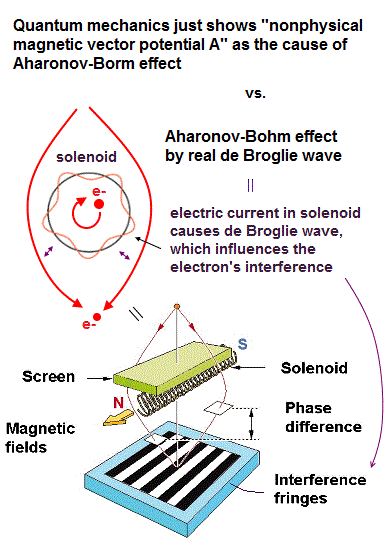
(Fig.1) Electrons flowing in the solenoid cause de Broglie wave around it.

It is known that even a single indivisible electron can interfere with itself in double-slit experiments.
The current unrealistic mainstream quantum mechanics claims that this single electron's interference in double-slit experiments is caused by an electron unscientifically splitting into many ( fictional ) parallel worlds.
An electron is known to generate de Broglie wave, which existence and interference were confirmed in many experiments such as Davisson-Germer and diffraction.
Using this real de Broglie wave traveling through real medium, we can naturally and realistically explain the double-slit interference of a single electron without relying on the fantasy quantum mechanical parallel worlds.
This electron's interference was affected by the long solenoid with electric current flowing inside it.
The long solenoid causes magnetic field only inside it, and generates almost no magnetic field outside the solenoid.
So the unphysical quantum mechanics started to claim that this change of electron's interference is due to the (unphysical) magnetic vector potential A allegedly generated around the solenoid's electric current, which is called "Aharonov-Bohm effect".
But quantum mechanics is unable to explain what this magnetic vector potential A really is, except for showing just the nonphysical meaningless mathematical symbols.
When an electron is moving and flowing as the electric current, it is known to generate de Broglie wave (= spreading over some area ), which can naturally affect the double-slit interference of the electron's de Broglie wave.
As a result, Aharonov-Bohm effect or electron's interference is caused by the realistic electron's de Broglie wave, Not by nonphysical magnetic vector potential or fictional quantum mechanical parallel worlds.
(Fig.2) Lorentz magnetic force = centrifugal force, and the circumference of an integer times de Broglie wavelength can explain the experimentally-verified magnetic flux quantum
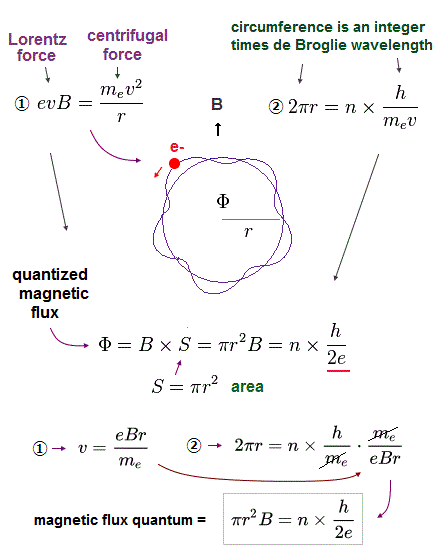
It is known that the magnetic flux threading a superconducting loop or hole is quantized as an integer (= n ) times magnetic flux quantum (= h/2e where "h" is Planck constant and "e" is the electron's charge ).
The unphysical quantum mechanics tries to explain this quantized magnetic flux using nonphysical phase θ, order parameters, and magnetic vector potential without showing any more concrete description.
We can naturally explain this magnetic flux quantum (= h/2e ) or Josephson constant (based on Josephson junction in SQUID ) using the realistic electron's de Broglie wave.
When the electron inside the superconductor is moving in a circular orbit under the applied magnetic field B, the magnetic Lorentz force = evB (= "v" is the electron's velocity, "B" is the applied magnetic field ) is equal to the centrifugal force (= mv2/r, where r is the radius of the electron's circular orbit ).
In order to avoid the destructive interference of the electron's de Broglie wave, the circumference (= 2πr ) of the electron's orbit should be an integral multiple of de Broglie wavelength (= λ = h/mv ).
From these two basic conditions, we can naturally derive the experimentally-verified magnetic flux quantum (= Φ = h/2e = πr2B ) in a realistic way without relying on the ad-hoc unphysical quantum mechanical phase or order parameter.
↑ It seems quantum mechanics desperately tries to avoid the word "de Broglie wave (= though, quantum mechanics heavily relies on de Broglie wave )", instead, quantum mechanics tries to use the more abstract (nonphysical) concept of "phase θ (= which actually means de Broglie wave's phase )"
Due to this quantized magnetic flux caused by an integral multiple of electron's de Broglie wave, the electric conductance (or resistance ) is changed with a periodicity of h/2e ( this p.4, this p.4 ).
See this.
(Fig.3) quantum Hall effect or Hall conductance (= 1/resistance ) in two dimensional electron system of low-temperature semiconductor under applied electric (= E ) and magnetic (= B ) fields.
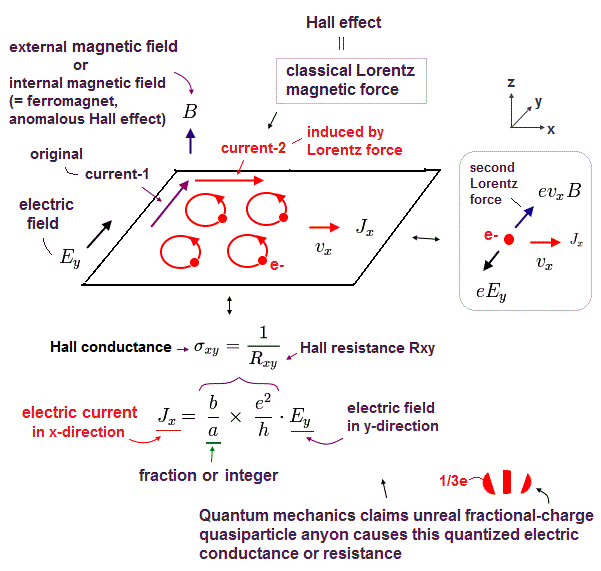
Hall effect or Hall current Jx (or Jy ) is induced in the direction perpendicular to the original electric current-1 by applied external electric field Ey (or Ex ) or voltage through classical Lorentz magnetic force under magnetic field B (= z direction ).
When this magnetic field B is due to internal magnetization (= caused not by unreal spin but by realistic orbital motion ) like in ferromagnet, this is called anomalous Hall effect.
The ratio of the induced electric current-2 (= x-direction ) to the original current-1 or electric field E (= y-direction ) voltage is called Hall conductivity (= σxy ) equal to 1/Rxy (= Rxy or ρxy is called Hall resistance or resistivity, this p.4-5, this p.11-12, this p.30 )
It is known that electrons can be moving around as electric current, confined in the thin layer (= 10~30 nm ) between some semiconductors and insulators called two-dimensional electron gas (= 2DEG ) system at very low temperature ( this p.2 ).
In this cold two-dimensional electron system, when the external magnetic field (= B ) is applied in z direction, and the external electric field (= E ) is applied in y directions, the electric (Hall) conductance (= σxy = reciprocal of resistance Rxy or ρxy ) expressed as the ratio of the electric current Jx in x direction to the electric field Ey in y direction becomes an integer or fraction of e2/h ( this p.2-4, this p.13, this p.4 ).
↑ This (integer or fractional) quantized electric (Hall) conductance or resistance is called (integer or fractional) quantum Hall effect.
The current unphysical quantum mechanics can only explain this (fractional) quantum Hall effect or electric conductance using unreal fractional-charge quasiparticles called "anyon ( this p.14-16, this p.3-left )."
We prove that these integer and fractional quantum Hall effect or electric conductance can be perfectly explained by the realistic electron's de Brolgie wave instead of unrealistic quantum mechanical quasiparticles.
(Fig.4) electric force (= eE ) is equal to magnetic force (= evB )

We derive the fractional and integer quantum Hall effect or Hall conductance (or resistance ) from the realistic electron's de Broglie wave.
When the whole electron is moving in x direction with the speed of vx under the external electric (= Ey in y direction ) and magnetic (= B in z direction ) fields, the electric force (= eEy ) becomes equal ( balanced ) to the magnetic force (= evxB ) like the upper equation.
(Fig.5) each circular current's area (= πr2 where r is radius ) in quantized Hall current

Under the external magnetic field B (in z direction ), the electron's orbit in semiconductor is quantized due to their de Broglie wave interference.
From Fig.2, we can obtain Fig.5
(Fig.6) Electric current Jx under the external electric (= Ey ) and magnetic (= B ) field.
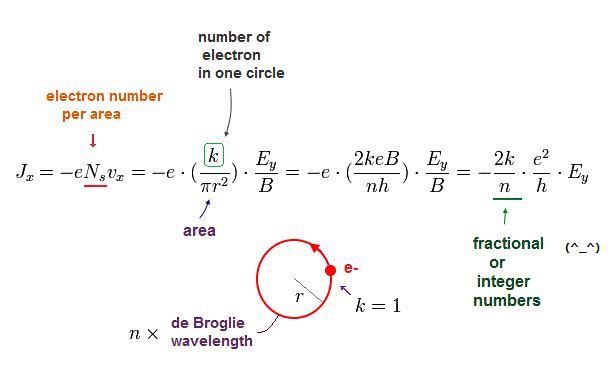
The electric current is expressed as the charge denisty (= e × electron's number density per area ) multiplied by the electron's velocity vx.
When the electron's orbit is quantized by de Broglie wave interference, the number of electrons (= k ) contained inside the circular orbit's area (= πr2 ) or electron's density is expressed as k/πr2.
From Fig.4 and Fig.5, we can get the equation of the upper Fig.6 where the Hall conductance becomes 2k/n × e2/h ( this p.6~8 = Hall resistance R is reciprocal of conductance = R = n/2k × h/e2 ), where k is an integer or electron's number contained in one orbit with n × de Broglie wavelength.
This value of 2k/n can be an arbitrary integer or fraction when we choose different combinations of integers k and n, which can explain the real fractional and integer quantum Hall effect, based on real de Broglie wave's quantization.
The observed total electric current is obtained by this quantized electric current density J multiplied by the total circular (current) area (= πr2 ), which is the same in any radius r (= when r is 1/2r, each circular area becomes 1/4πr2, but the original one circle splits into four smaller circles, so the total circular area becomes the same = 1/4πr2 × 4 = πr2 ).
As shown in Fig.8 and Fig.9 where each orbit closely surrounded by six other orbits in hexagonal way, the same phase (= an electron + the other orbit's hole ) of de Broglie waves tends to attract and tries to contact each other as much as possible, and the flexible electron's de Broglie wave orbits can reduce the gap.
The upper Fig.6 case shows when all the circular orbits are filled with electrons, but actually there is a limit to the maximum number of conducting electrons.
↑ As the applied magnetic field B is stronger, each circular current area becomes smaller (= densities of positive nuclei remain the same ), which needs more conducting electrons filling all smaller circular orbits in Fig.3 and Fig.6.
↑ Due to the upper limit of the number of valence (= or conducting ) electrons, as the applied magnetic field B is stronger (= each circular current area becomes smaller, and the number of smaller circular currents increases ), the number of circular currents empty of electrons increases, so Hall resistance R (= or ρ ) increases (= Hall current or conductance decreases ) as the applied magnetic field B increases.
↑ Due to an integer times de Broglie wavelength, as the applied magnetic field B increases, Hall resistance R or ρ increases as R/integer or ρ/integer (= Hall conductance σ decreases like an integer × σ ), which causes (integer or fractional) quantum Hall effect ( this figure.2 ).
(Fig.7) Electron's de Broglie wave
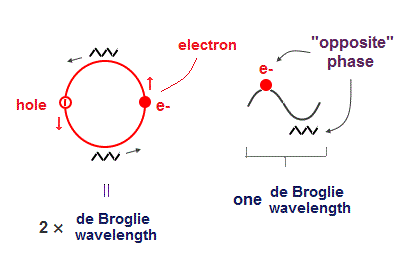
In order to avoid the destructive interference of electron's de Broglie wave, each electron's orbit must be an integer times de Broglie wavelength.
One de Broglie wavelength consists of a pair of the opposite phases.
(Fig.8) When each 2×de Broglie wavelength orbit ( n = 2 ) contains one electron (= k = 1 ), it becomes an integer quantum Hall effect.
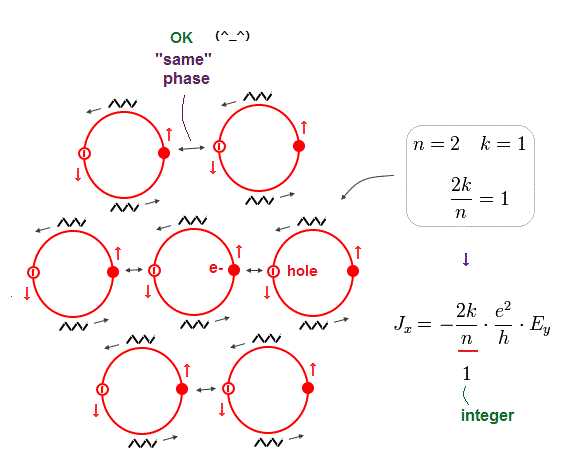
As shown in the upper figure, when each orbit with 2 × de Broglie wavelength (= n = 2 ) contains one electron (= k = 1 ), it can explain an integer quantum Hall effect where the Hall conductance is 1 (= 2k/n = 1 ) × e2/h
(Fig.9) Each electron can pass an empty hole of the neighboring atom
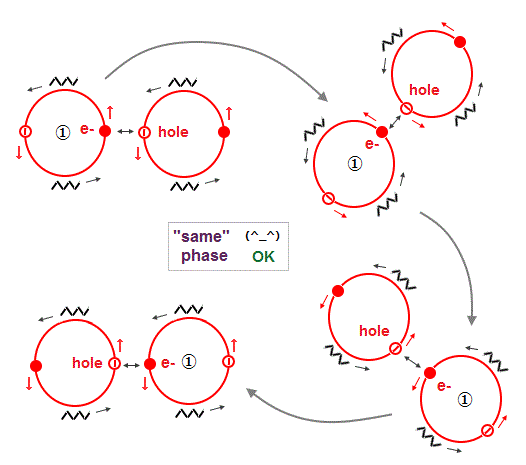
In the case of the integer quantum Hall effect of Fig.8, each electron can pass an empty hole of the neighboring orbit safely and smoothly as electric current.
(Fig.10) Integer quantum Hall effect with integer quantized electric conductance (or resistance ).
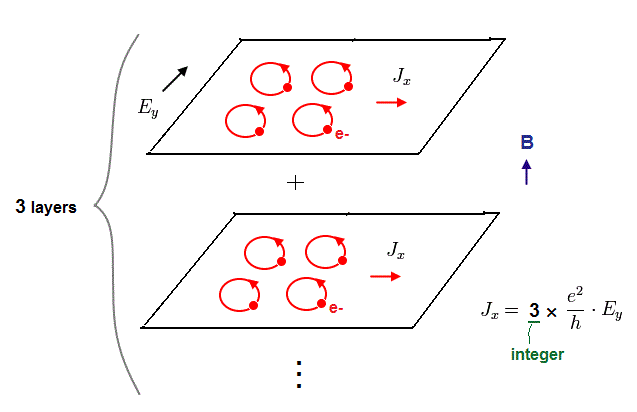
Basically, the two-dimensional electron gas system (= 2DEG ) has some thickness of about 10~30 nm, which can contain multiple layers of electric current (= because one atomic diameter is about 0.1 nm ).
When three layers of electric currents are flowing, this becomes the integer = 3 quantum Hall effect or 3 × Hall conductance of 1.
In this way, we can explain an arbitrary integral number of quantum Hall effect using the realistic electron's de Broglie wave.
(Fig.11) Real mechanism causing fractional quantum Hall effect without using unreal quantum mechanical fractional-charge quasiparticles.
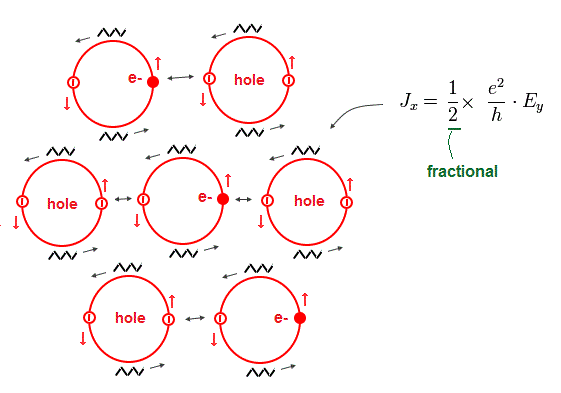
As shown in the upper figure, when every two orbits contain only one electron (= k = 1/2, n = 2 ), it becomes the fractional quantum Hall effect with fractional Hall conductance of 1/2 (= 2k/n = 1/2 when k = 1/2 and n = 2 ) × e2/h.
When every three orbits contain only one electron, it becomes 1/3 fractional quantum Hall effect.
When there are five layers of the electric current of this 1/3 quantum Hall effect, it becomes 5/3 fractional quantum Hall effect.
In this way, we can successfully explain an arbitrary number of fractional quantum Hall effect using the realistic electron's de Broglie wave.
The electric conductance (= reciprocal of electric resistance ρxy ) and how many layers of electric current are involved are affected by the strength of applied magnetic field B. = More stronger magnetic field B is applied, the orbital radius r is smaller = number of electrons (= k ) contained in one orbit is smaller ( due to stronger repulsion between neighboring electrons ) = the electric conductance is smaller (= electric resistance is bigger), and the number of electric current layers becomes smaller.
The 2nd, 5th, 6th paragraphs of this hyped news say
"But in very special states of matter, electrons can splinter into fractions of their whole (= wrong, because an electron splitting is impossible ). This phenomenon, known as "fractional charge," is exceedingly rare, and if it can be corralled and controlled, the exotic electronic state could (= just speculation ) help to build (illusory) resilient, fault-tolerant quantum computers (= which will never happen )."
"They found that when five sheets of graphene are stacked like steps on a staircase, the resulting structure inherently provides just the right conditions for electrons to pass through as fractions (= fake news, again ) of their total charge, with no need for any external magnetic field."
"The results are the first evidence of the fractional quantum anomalous Hall effect (the term "anomalous" refers to the absence of a magnetic field) in crystalline graphene"
↑ This research just measured slight electric current ( or electric resistance called Hall resistance = Rxy ) generated perpendicularly to the applied electric field in graphene at extremely cold temeprature (< 4K, this p.3~4 ), and tried to explain it using fictional fractional-charge quasiparticle called anyon ( this p.10 anyon quasiparticle ) with No quantum mechanical prediction.
In Hall effect, electric current (= called Hall current or Hall conductance ) is known to occur also in the direction perpendicular to the applied electric and magnetic fields (= due to Lorentz magnetic foece, this 2~6th-paragraphs ), which can be naturally explained by classical Maxwell theory ( this middle, this p.4~ ).
Because the electron's orbit (= Not quantum mechanical illusory spin ) is quantized due to satisfying de Broglie wave condition ( an electron orbit must be a quantized integer times de Broglie wavelength to avoid destructive interference ), this Hall current, conductance or resistance is also quantized ( this p.15 ), which is called quantum Hall effect (= quantum Schrodinger equation is also based on quantized de Broglie wave theory like Bohr's realistic orbit ).
↑ When this Hall conductance σ is a fractional number × e2/h (= or Hall resistance is an integer times h/e2, this p.2 ), it is called fractional quantum Hall effect (= FQHE ).
Quantum mechanics ridiculously insists this fractional quantum Hall effect (= just measuring some electric conductance, this p.14 ) is due to ( unreal ) fractional-charge quasiparticle ( this 5th-paragraph ) called anyon into which an indivisible electron is said to magically split.
↑ This fractional-charge (which only unseen quarks are said to possess ) or quasiparticle anyon is unreal, because it is impossible to divide an elementary particle electron ( this p.2-2nd-paragraph ) or observe fractional-charge. ← The current mainstream quantum mechanics is self-contradictory.
In anomalous Hall effect, even without external magnetic field, this Hall current is observed due to intrinsic magnetic field like in ferromagnetic material ( this p.1-2nd-last-paragraph ).
In this research, when graphene sandwiched between some material (= boron nitride ), the slight fractional quantum anomalous Hall effect was said to be observed (= probably due to transient internal magnetic field ) only at extremely low temperature = almost absolute zero (< 4K, this p.3, p.4-Fig.1 ), which extremely-low temperature makes this graphene's quantum Hall effect impractical.
In order to seemingly explain this imaginary fractional charge quasiparticle or fractional quantum Hall effect, physicists always tried to rely on the useless one-pseudo-electron DFT model with artificially-chosen (unreal) pseudo-potential ( this p.13-left-1st-paragraph used empirically-obtained graphene lattice constant and DFT model with quantum espresso that relies on unreal pseudo-potential in parametrization of C.pz-rrkjus.UPF, this 3~7th-paragraphs ).
↑ Artificialy-chosen pseudo-potential model (= which is not unique, this p.2, this p.6 ) means No quantum mechanical prediction, and this quantum mechanical pseudo-model lacking real particle picture stops our scientific development forever.
Sadly, only publishing papers in academic journals is the current researchers' only purpose, and this impractical pseudo-science ruins the researchers' careers and future.
As shown in this fictional fractional-charge quasiparticles, the so-called 'wonder material graphene' is the target of quantum mechanical impractical pseudo-concepts.
To hide this inconvenient truth of deadend quantum mechanics or graphene research, a lot of overhyped news was spread about the graphene which still has No real utility or advantage ( this 4th-paragraph, this 5th-paragraph ).
The 1st, 3rd, 7th, 10th, 23th, last paragraphs of this hyped news say
"In a novel experiment, physicists have observed long range quantum coherence effects due to Aharonov-Bohm interference in a topological insulator-based device. This finding opens up a new realm of possibilities for the future (= just speculation, still useless ) development of topological quantum physics (= topological quantum physics is just an impractical pseudo-science ) and engineering."
"Princeton scientists developed a quantum device—called a bismuth bromide (α-Bi4Br4) topological insulator—only a few nanometers thick and used it to investigate quantum coherence."
"Unlike conventional electronic devices, topological circuits are robust against defects and impurities, making them far less prone to energy dissipation (= just imagination ), which is advantageous for greener applications (= topological is just fictional math concept, so No evidence of robust nor application )"
"A special type of topology is also possible in certain bismuth-based materials where some edges can be gapped and only some hinges remain conducting."
"such a quantum interference occurs if the conduction electrons remain phase coherent after completing closed trajectories, resulting in a periodic oscillation in electrical resistance (= which this experiment just measured, "topological" objects did Not appear in this experiment ) with a characteristic period of the magnetic field ΔB = Φ0/S, where Φ0 = h/e is the flux quantum"
"It's a discovery that could potentially (= uncertain future, still useless ) lead to exciting advancements in quantum devices."
↑ This research just measured slight electric resistance (= R ) oscillation of the tiny topological insulator Bi4Br4 under (changed) magnetic field B at extremely low temperature (= only 30mK = almost absolute zero ), which extremely-cold temperature shows No practical application.
↑ They claim this slight electric resistance oscillation may be the sign of (fictional) quantum interference caused by Aharonov-Bohm effect or magnetic flux quantum (= Φ = h/2e, this p.4,10,12 ).
When there is a hole in the superconductor, magnetic flux is known to be trapped in this hole. This magnetic flux trapped in the hole must be quantized in units of h/2e, which is called manetic flux quantum.
Quantum mechanics tries to avoid realistic interpretation of these "quantum interference (= which is said to be caused by fantasy quantum parallel worlds )", Aharonov-Bohm effect and magnetic flux quantum, all of which can be naturally explained by realistic de Broglie wave interference ( this p.5 ).
↑ This research ( this p.19-Theoretical calculation ) tried to explain the electric properties of this topological insulator using the fictional one-pseudo-electron DFT model with VASP (= which depends on artificially-chosen pseudo-potential, this p.11-12 ) and Wannier90 code which must also artificially choose band energies ( this-1~3, this-step.0~1 ) with No quantum mechanical prediction.
As a result, topological insulator like this research just measuring slight electric current oscillation at extremely-low temperature (= 30mK ) is a useless hyped science (= still in its infancy forever, this last-paragraph ), and their quantum mechanical theory lacking real atomic picture stops scientific progress and innovation.
This useless unscientific topological insulator is also one of typical examples of researchers aiming only at publishing papers in journals instead of really atiming to invent useful machines. → Only hypes remain.
The 4th, 7th, 14th, 16th, 17th, 18th, last paragraphs of this hyped news say
"The researchers used pulses of electrical current to switch the direction of the device's magnetization (= just magnetization, Not spin ) at room temperature. Magnetic switching can be used in computation."
"In the future, such a magnet could (= just speculation, still useless ) be used to build faster computers that consume less electricity"
"fabricated a two-layer magnetic device using nanoscale flakes of iron gallium telluride (= Fe3GaTe2 ferromagnet ) underneath a six-nanometer layer of platinum (= Pt )."
"While electrons don't technically "spin" like a top, they do possess the same kind of angular momentum.. The researchers can leverage a property known as spin-orbit coupling to control the spins of electrons they fire at the magnet (← This explanation is self-contradictory, because they say electron does Not spin. but it uses spin-orbit coupling !? )."
"The same way momentum is transferred when one ball hits another, electrons will transfer their spin momentum to the 2D magnetic material when they strike it. Depending on the direction of their spins, that momentum transfer can reverse the magnetization." ← False, because spin (angular) momentum does Not change ( this 1st-paragraph ), hence, transferring ( unchanged, unmovable ) spin momentum to other material is impossible.
"In a sense, this transfer rotates the magnetization from up to down (or vice-versa), so it is called a "torque," as in spin-orbit torque switching (= all of this description is just imagination, because unrealistic spin itself is directly undetectable ). Applying a negative electric pulse causes the magnetization (= electric → magnetic change ? ) to go downward, while a positive pulse causes it to go upward."
"Our next milestone is to achieve switching without the need for any external magnetic fields (= this means this experiment applied not only electric current but also external magnetic field, needing both electric and magnetic fields as input is energy-inefficient, and explanation of electric current transformed into magnetic switch is false. ). Our aim is to enhance our technology and scale up to bring the versatility of van der Waals magnet to commercial applications (= still Not commercial application )"
↑ This research just flowed electric current (= I ) in platinum (= Pt ), tried to cause some magnetization in the neighboring ferromagnet Fe3GaTe2 ( this p.1-right, p.4 ), which magnetic field was detected by (classical) Hall effect as the change of electric resistance (= Rxy = Hall resistance ). ← Electron spin itself is undetectable and irrelevant, and No quantum mechanical prediction nor calculation was made in this research (= real mechanism is unclear ).
↑ They tried to change the applied electric current (= I ) into magnetization by using (paradoxical relativistic) spin-orbit coupling expressed as spin Hall effect (= irrelevant to ordinary quantum Hall effect ), which is physically impossible.
In the (relativistic) spin-orbit (fictitious magnetic) coupling or spin Hall effect, a moving electron does Not feel magnetic field from a stationary nucleus (= Not spin-orbit magnetic coupling ), but they paradoxically insist the (fictitious) magnetic field may happen seen by the moving electron from which the originally-stationary nucleus appears to be moving and cause magnetic field that may be felt by the (fictional) stationary electron's spin ( this p.2-Fig.3 ).
↑ So this (relativistic) spin-orbit effect, which may occur or not occur depending on the observers' viewpoints (= seen by nucleus or by electron ), is paradoxical and impossible.
↑ This mechanism of electric current switching magnetic field is much more complicated and uncertain.
They argue after (fictional) spin Hall effect caused by (paradoxical) spin-orbit coupling generated magnetic field parallel to the surface of the ferromagnet Fe3GaTe2 (= this green arrows ), this magnetic field could rotate (= precess ? ) the ferromagnet's magnetic direction (= this M yellow arrow ) up or down ( this p.3-Fig.2a, this Fig.1 ), which explanation is just baseless imagination and too good to be true.
The problem of this experiment is another external magnetic field (= Hext in this Fig.3a ) applied in the different direction (= in-plane magnetic field, this p.3-right-1st-paragraph, p.4-left ) was necessary (= the original spin-orbit theory changing electric into magnetic field should Not need this input external magnetic field ) in addition to applied electric field to change this ferromagnet's magnetic direction ( this last-paragraph ).
This p.9-conclusion (= research similar to this ) says
"However, an in-plane magnetic
field is still required to break the in-plane symmetry for deterministic switching in our
SOT (= spin-orbit torque ) devices, which is challenging for device integration."
↑ So this (fictitious) spin-orbit coupling-based magnetic switching needs both magnetic and electric fields as input, which is much more energy-inefficient and impractical ( this p.2-abstract ) than the conventional magnetic switch (= like hard-disk drive ) that needs only magnetic field ( caused by input electric current ) to change the target's magnetization without needing another external magnetic field.
This p.6-last-paragraph says
"However, compared to the RH (= Hall resistance detected as a sign of magnetization switch ) switched by the external
perpendicular magnetic field (= case when only magnetic field is applied to change magnetic switch like conventional technique ), the current-driven RH (= using illusory spin-orbit effect caused by electric current ) is only 40% of that (= spin-orbit-coupling-based magnetization switch is weaker ), indicating the current-driven
magnetization switching is partial and incomplete"
↑ Such an inefficient (spin) electric current-driven mangetic switch is unnecessary. Conventional magnetic field-driven switch is OK.
Furthermore, the estimated spin-orbit torque (= SOT ) efficiency (= how correctly spin-orbit effect can change the target magnetic field, the maxium is 100% or 1.0 ) in this latest experiment is only ξ = 0.098 (= only about 10%, this p.5-(5) = bad efficiency ), which is worse than even older experiments ( this p.9, this p.2= SOT efficiency is 0.26, this p.9= efficienty is 0.22 ).
And these kinds of experiments about spin-orbit torque switching do Not perform any quantum mechanical calculation nor prediction ( this p.6-methods used No Schrodinger equation nor one-pseudo-electron DFT ). ← So the alleged spin-orbit torque mechanism remains unclear, and quantum mechanics and its fictional spin are unable to give real mechanism ( this p.8-b. first principle ).
This p.2-left-1st-paragraph says
"the origin of the spin-orbit
torques is still unclear and controversial even in the prototypical spin-orbitronic device"
As a result, quantum mechanics (= promoted by academic journals as "scriptures" ) prevents researchers from developing useful technology by forcing them to use impractical pseudo-models and paradoxical relativistic spin-orbit effect.
In order to explain the electric current influencing the magnetization, the realistic electron's orbital motion (= instead of fictional spin ) is necessary. ← In this experiment, the realistic explanation is that the electric orbital motions were aligned by external magnetic field (= Hexp in the direction parallel to the surface of ferromagnet Fe3GaTe2 ), and these orbiting electrons' currents (= I ) aliged in the same direction collided with ferromagnet's electrons' orbits (= which are also aligned in the same direction ) and changed this orbital or magnetic field in some particular direction.
The 1-7th, 9th, last paragraphs of this hyped news say
"A new magnetic material.. could (= just speculation ) boost computer memory storage by enabling higher memory density and faster memory writing speeds (= false, this research's method will worsen the computer memory, and lower the density, contrary to this hype )."
"Memory devices such as hard disks store data by creating different magnetization patterns across a magnetic material. They use magnetic materials known as ferromagnets"
"The trouble with ferromagnets is that neighboring areas can interfere, causing spontaneous magnetization that corrupts data"
"Antiferromagnetic materials, in which the magnetic fields of adjacent atoms tend to line up in opposing directions, are promising for addressing these challenges. But because magnetization cannot be observed in antiferromagnets, physicists would need a different technique to encode and read out data (= false, magnetization is necessary also in antiferromagnet, after all )."
"For the past 20 years, physicists have been suggesting that certain antiferromagnetic materials could support a different kind of behavior, called the "anomalous Hall effect." It could (= just speculation ) be used to manipulate electrons in antiferromagnetic materials to store and readout data (= false. Even after 20-year researches, anomalous Hall effect in antiferromagnet is still impractical, which means "impractical forever" No progress )."
"The conventional Hall effect was first observed in non-magnetic materials more than a century ago (= quantum mechanics is irrelevant ) by American physicist Edwin Hall. When an electric field is applied to a conducting material, the electrons move in a straight line along the material, parallel to the electric field. But Hall discovered that when an external magnetic field is also applied, the path of the electrons bend (= this is explained by classical Lorentz magnetic force, Not by quantum mechanics )."
"Later, Hall discovered that this bending can happen in some magnetic materials too, even when no external magnetic field is applied—a phenomenon that was dubbed the anomalous Hall effect (= but this needs ferromagnet's internal magnetic field causing Lorentz magnetic force to electrons, this p.1-introduction-2nd-paragraph )."
"The anomalous Hall effect had previously been seen in more-complex types of antiferromagnets. But this is the first time the effect has been observed in an antiferromagnetic metal that has a simple co-linear structure (= these antiferromagnets also include small internal magnetic field under some special condition, which mechanism is almost the same as ferromagnet after all )"
"We hope (= just speculation, still useless ) our work inspires others to search for other materials that are cheap and easy to make"
↑ This research just measured slight anomalous Hall effect (= material's small internal magnetic field bent electronic flow by Lorentz magnetic force, and generated small electric current or Hall conductivity σxy perpendicular to applied electric field without external magnetic field ) in antiferromagnet's bulky material at extremely-low 3K temperature (= impractical ) with No quantum mechanical prediction nor application.
↑ Antiferromagnet is said to have no explicit magnetization available for data storgage, so they tried to inconveniently use the change of electric conductance, current or voltage (= Hall conductivity σxy ) as a bit 0 or 1 ( this-4th-paragraph ).
But measuring the electric conductance and current needs much bigger space than the present practical compact hard disk ferromagnetic bit.
This research used a big 300μm × 60μm antiferromagnetic bit ( this p.6-right-3rd-paragraph ) for measuring each Hall conductance (= which is used as a bit ) at extremely-low 3K temperature, which is far worse, more energy-inefficient than the current practical hard disk's compact magnetic bit of only 50nm size ( this p.1-middle ).
So this news 1st paragraph saying "could boost computer memory storage by enabling higher memory density and faster memory writing speeds" is just a overhyped fake news (= this bigger antiferromagnet device is far lower density and slower than the current hard disk ferromagnetic device ).
Actually, this research author just said ( this p.6-left-3rd-paragraph )
"We envision that this
material-design strategy may also work and be helpful to explore the AHE (= anomalous Hall effect )" ← No mention of practical data storage or memory.
Furthermore, unlike the anomalous Hall effect in ordinary ferromagnet caused by internal magnetization, this antiferromagnet is said to have no internal magnetization.
So quantum mechanics unscientifically started to insist anomalous Hall effect in antiferromagnet may be caused by fictitious magnetic field called Berry curvature or Berry phase ( this p.4-1st-paragraph ) related to illusory monopole ( this p.4-last-paragraph ) !
↑ This research paper ↓
p.1-left mentions Berry curvature = fictitious magnetic field ( this p.1-right-last-paragraph ).
p.3-Fig.2c shows the slight magnetization (= M ) splitting into two at zero external magnetic field (= H = 0 ) at 3K (= used as a impractical bit ? ).
p.5-Fig.4a shows slight Hall conductance (= σxy ) splitting at zero external magnetic field H = 0 (= so anomalous Hall effect in antiferromagnet is also caused by small internal magnetization M after all, Not by fictitious Berry curvature )
p.6-DFT calculation based on one-pseudo-electron used artificially-chosen pseudo-potential and freely-fitting DFT+U parameter ( this p.5-Fig.3 ) with No quantum mechanical prediction.
As seen here, quantum mechanical unphysical models such as fictitious magnetic Berry curvature, monopole, one-pseudo-electron DFT, pseudo-potential lacking real particle figures obstruct technological innovation such as memory, and eventually needs overhyped fake news.

Feel free to link to this site.